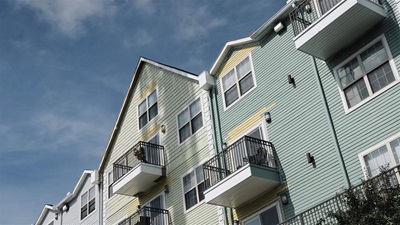Proposal Could Lower Manufactured Home Costs, Expand Housing Supply
Ending chassis requirements would bring greater design flexibility and factory efficiency

A proposed federal rule change included in the bipartisan Road to Housing Act could cut the cost of manufactured homes by as much as 9% and make them easier to place in cities and suburbs. The change, part of a wide-ranging measure that was passed unanimously by a Senate committee in July, would allow for the removal of a manufactured home’s “chassis,” the steel frame that factory-built homes are assembled and delivered on.
Although the frames, or chassis, serve a key purpose in the building and siting of manufactured homes, they are rarely needed after delivery—only 5% to 7% of manufactured homes are moved. Still, keeping the frame can increase home prices by about $10,000, or 9% of the average, single-section home cost.
Housing experts say that allowing the chassis to be removed after installation would also allow greater design flexibility. Manufactured homes could be placed in more communities—not only in rural areas but also in empty lots in cities—while waste and cost could be reduced. The current requirements have been in place since 1976 to allow for the homes to be moved when needed. However, because almost all remain on their original lots after installation, the mandate has outlived its original usefulness. Meanwhile, policymakers today have been exploring ways to encourage greater use of manufactured housing to help address the nation’s growing shortage of lower-cost homes. Although manufactured homes are a critical source of lower-cost housing, the industry has not fully recovered from the Great Recession, and shipments remain at just one-third of 1990s levels.
Implementing a chassis removal option would be an important step toward increasing where manufactured homes can be used. For example, depending on the market, the change could make it easier to build multilevel units or basements, and to have the main levels closer to the ground. Additional state and local policy updates could further improve the usability and affordability of these homes. While allowing chassis removal after transportation would expand use cases and options, this alone would not be enough. Additional policy updates, such as modernizing zoning and ownership laws to expand access to mortgage financing, would still be needed so this option can reach its full potential to help address the deep national housing supply shortage.
Why manufactured homes have permanent chassis
Unlike site-built homes, which are largely regulated at the local level, manufactured homes are built to a set of federal construction standards set by the Department of Housing and Urban Development and referred to as the “HUD code.” One of the requirements is that manufactured homes must be built on a steel chassis. The origins of the requirement are not clear, but some experts suggest that policymakers felt that the chassis were essential for the homes to remain moveable and to increase stability if they were not on permanent foundations.
However, given that moving manufactured homes is challenging and expensive—and the reality that just 5% to 7% of such homes are ever moved once installed—the requirement is no longer needed. Furthermore, in cases in which the home is permanently attached to a foundation, usually when the homeowner also owns the land beneath the home, the chassis isn’t required for structural support and can be a hindrance. The requirement can add thousands of dollars in extra costs, make it impossible to build multilevel or multiunit homes in higher-cost markets or on smaller lots, cause basements to be dug deeper, and prevent homes from being closer to the ground, when that would be preferable. Allowing greater flexibility in configuring manufactured homes could help expand this lower-cost option in urban centers. For example, manufactured homes could provide a crucial source of housing on vacant lots and in higher-cost markets where multistory manufactured housing configurations are needed.
Removing chassis can reduce cost and increase design flexibility
Updating HUD code to allow the removal of the chassis could both make homes more affordable and provide builders and developers with greater design flexibility to meet the wants and needs of a diverse range of communities and neighborhoods. According to the Niskanen Center, a public policy think tank, removing the chassis requirement could reduce the cost of manufactured homes by anywhere from $5,000 to $10,000, roughly 7% to 9% for the average, single-section manufactured home.
In terms of material costs, builders would no longer have to build one chassis per section of home and could instead reuse a single chassis across multiple units. They could transport each section on a chassis that would then be removed and reused for future shipments. Removing the requirement would also save on installation costs; builders would no longer have to dig basements deep enough to contain a large steel frame.
Without the chassis, builders could better cater to the preferences of prospective homebuyers. More cities and densely populated communities would be able to benefit as well. For multilevel homebuilders, chassis removal would allow units to stack more easily without including the additional height and weight of a steel chassis on the upper-level section in the ceiling of the ground floor.
Next steps for state and local policy
Allowing manufactured homes to be made with removable chassis would be an important step forward. However, additional steps are needed at the state and local levels to ensure that these homes are treated like other homes. For example, policymakers at times justified exclusionary zoning regulations that precluded manufactured homes from a community simply because the chassis allowed those homes to be moved. Even with the chassis requirement in place, lawmakers in nine states over the past five years have recognized the importance of access to manufactured housing as a source of lower-cost homes and passed legislation to require zoning policies to allow them. Removing the chassis requirement altogether could provide even more impetus for states and localities to update policies.
Similarly, titling laws that automatically treat manufactured homes as movable or “personal” property (much like a car or trailer) must be reconsidered because they can inhibit the use of this option. Mortgage financing can be obtained only when a home is owned as real estate. Although most states allow the conversion of personal property to real estate, only about half of manufactured homes are titled that way, so mortgage financing becomes impossible regardless of the quality of the home or borrower qualifications. This results in higher borrower costs and fewer consumer protections.
Updates to chassis requirements and titling rules would help to ensure that manufactured homes are treated like other single-family homes and are eligible for mortgages. Improving policies across the board would help to expand the use of manufactured housing to better meet the needs of American families and boost its role in addressing the nation’s housing shortage.
Dennis Su is an associate and Rachel Siegel is a senior officer with The Pew Charitable Trusts’ housing policy initiative.















